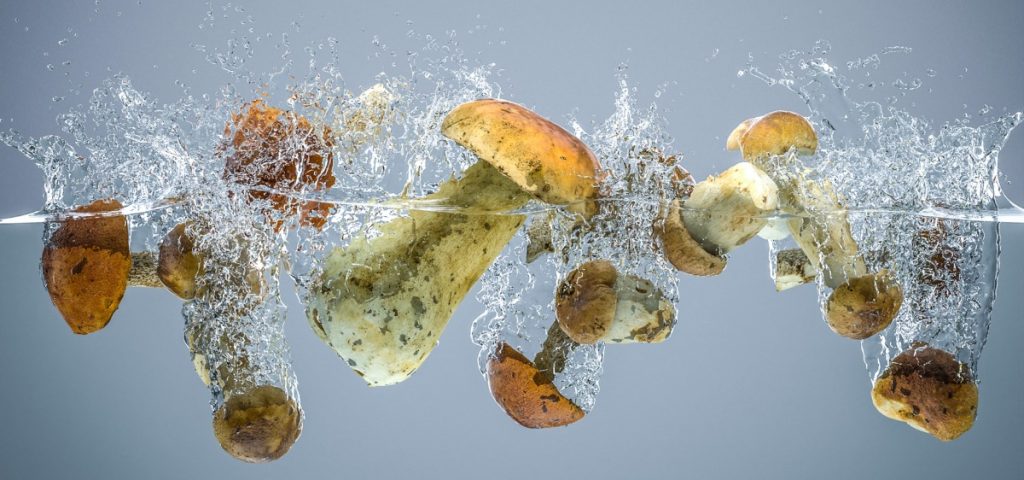Mushrooms are a delicious and nutritious addition to any meal, and as they’re so versatile, you can use them in a range of different dishes.
They’re also not difficult to cook. But, to get the best possible flavor and texture, you must store and clean mushrooms properly.
In this article, we look at how to clean different types of mushrooms so that you can safely enjoy all the benefits these amazing fungi offer.
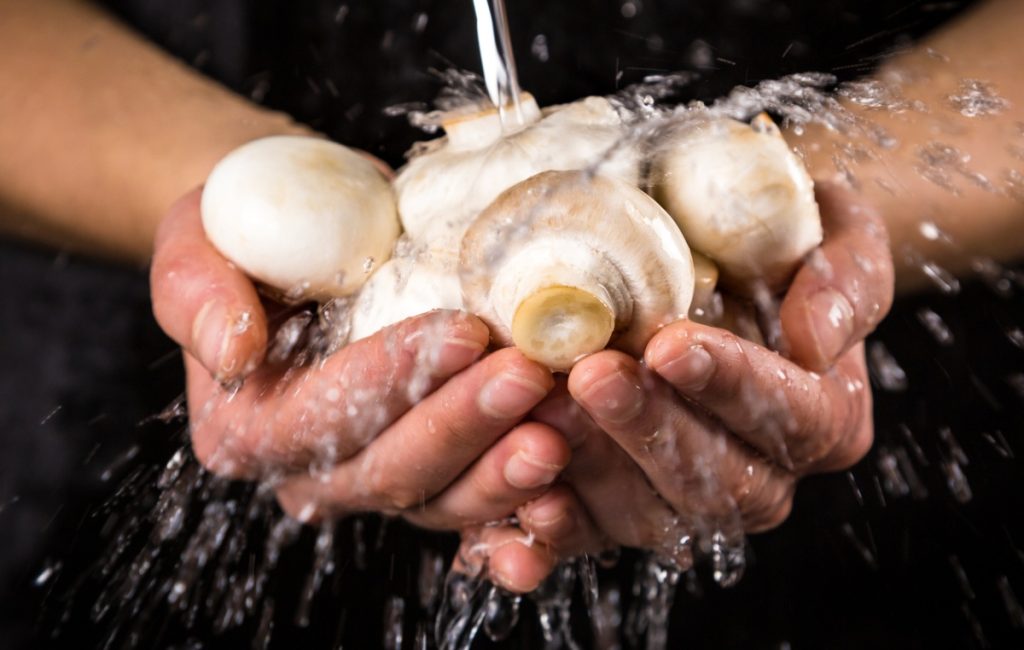
How to Clean Mushrooms?
Depending on your favorite chef, which blogs you follow and who taught you to cook, you may get conflicting messages on how to clean mushrooms.
But one thing we can say is that when cleaning and preparing mushrooms, there’s no need to peel most mushrooms. What’s more, peeling mushrooms can make them less flavorful.
There are two sides to the ongoing mushroom cleaning debate. Some people believe you should only brush mushrooms clean, while others suggest washing them with water.
You can find arguments for both, but which method you ultimately choose will depend on how you source your mushrooms, the type of mushrooms you’re preparing and how you intend to use them.
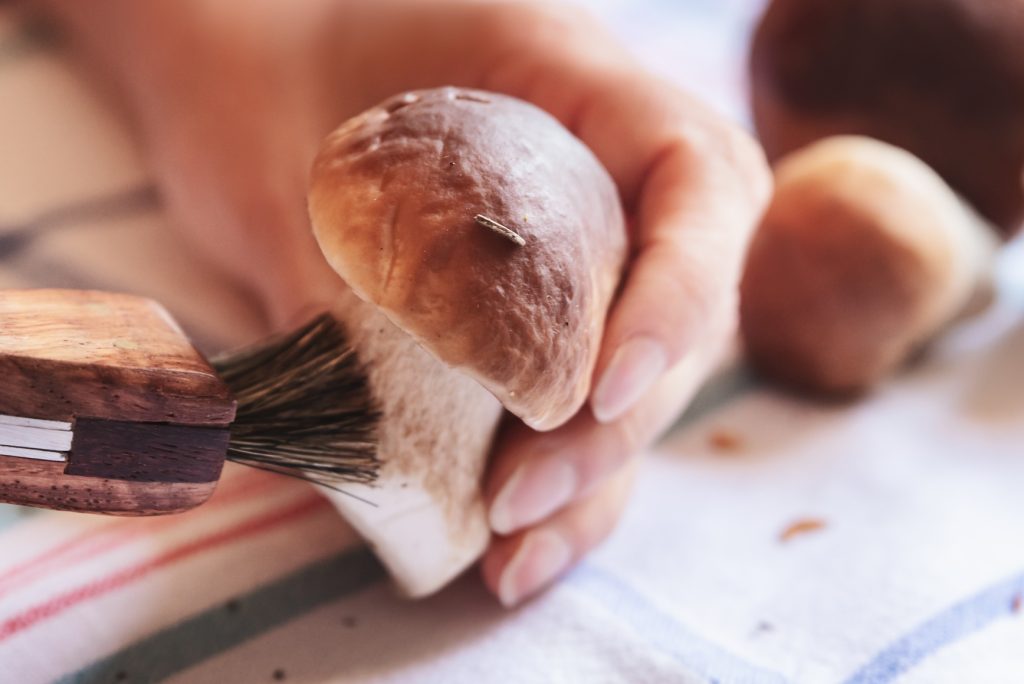
Are You Supposed to Wash Mushrooms?
Store-bought mushrooms often still have a bit of debris attached to them as they’ve grown in compost. And wild mushrooms collected in forests may come with dust, insects and debris.
So you’ll need to clean them to remove any dirt, bacteria, insects or mold.
The argument for not washing mushrooms is that mushrooms are like sponges and are already more than 80% water.
So, if you wash them, they’ll absorb more water, become waterlogged and be soggy and flavorless when cooked.
But brushing off each mushroom individually with a small brush or paper towel takes a long time, and in our opinion, it’s unnecessary.
A quick rinse in water gets rid of debris and does not cause mushrooms to become waterlogged.
Around 150 grams ( 5.29 ounces) of mushrooms is only capable of absorbing about an extra 5 grams (0.18 ounces) of water. And, any excess water they may soak up will cook-off in the pan.
But what if you plan on serving your mushrooms raw?
How Do You Clean Mushrooms You’re Serving Raw?
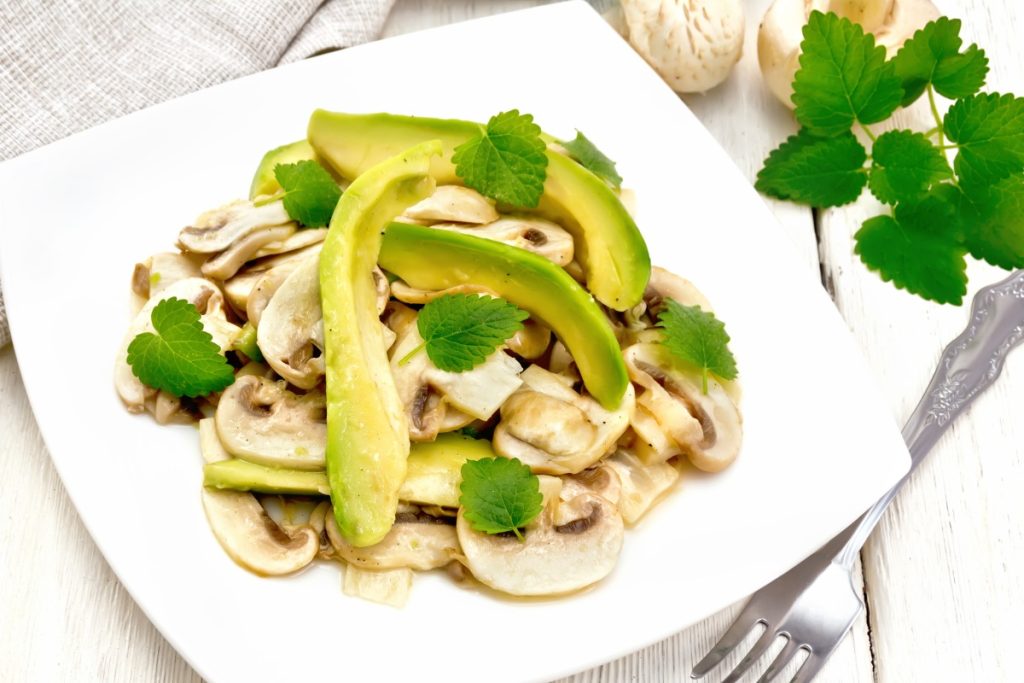
Sometimes salad recipes may call for sliced raw mushrooms or crunchy raw enoki mushrooms to create a fresh, crisp meal.
In these instances, avoid running water over your mushrooms unless it’s really necessary.
Rinsing mushrooms, especially wild mushrooms, can cause discoloration. And, because you are not cooking the mushrooms, this will be visible and unappealing.
Rather, use a dry pastry brush, toothbrush or paper towel to rub off loose dust and debris. And a paring knife to trim off crusted dirt and any damaged or bruised sections of the mushroom.
We generally recommend cooking mushrooms before you eat them. Doing this helps break down the chitin, a fibrous substance made of polysaccharides in the cell walls of raw mushrooms.
Chitin is hard for humans to digest, but cooking breaks it down, making it easier for us to access all the healthy nutrients mushrooms have to offer.
Another good reason to cook mushrooms before eating them is that it destroys a carcinogenic toxin called agaratine found in some mushrooms.

How Do You Clean Mushrooms Before Cooking?
As cooking mushrooms destroys many of the toxins and bacteria they may have, you may be wondering: “Do you need to wash mushrooms before cooking them?”
Commercially produced mushrooms are grown on sterile manure that won’t cause any harm if eaten. But, having bits of grit in your delicious mushroom dish can ruin the entire meal.
And, sometimes insects and bits of dirt may be hiding in the gills of the mushroom.
Depending on the type of mushroom, you may be able to brush off all the dirt, but washing them in water is often quicker and more effective.
No matter what type of mushrooms you’re cleaning, you should only wash them right before cooking them.
When you wash mushrooms, they absorb water and are more likely to rot or go moldy afterward.
Below are some step-by-step guides on how to clean mushrooms before you cook them.
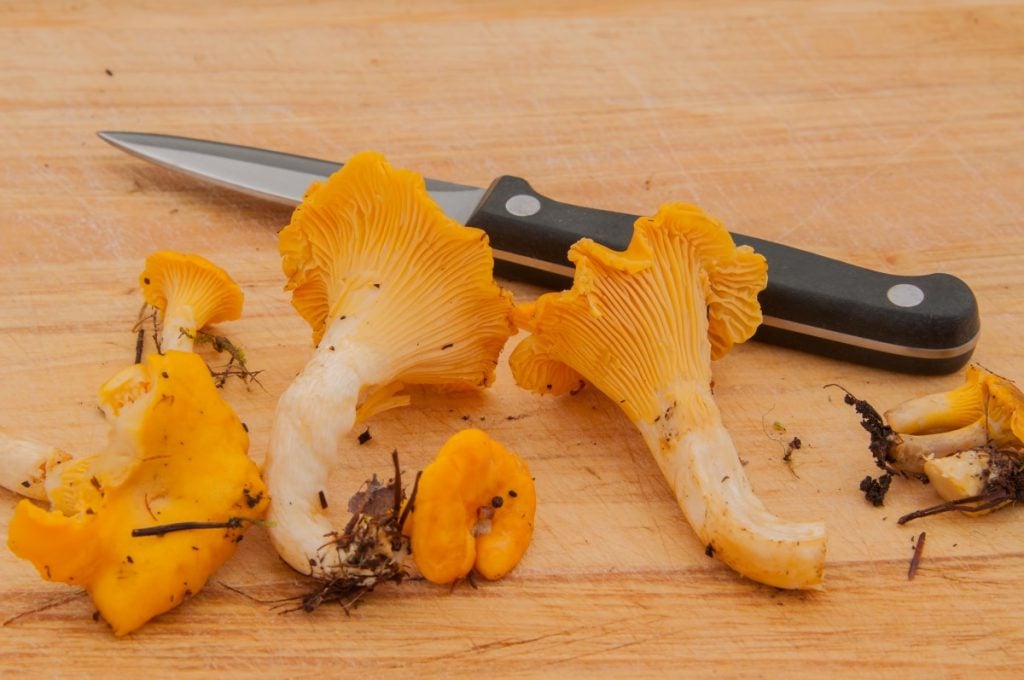
Step by Step Guide to Cleaning Whole Mushrooms
If you plan on baking, sauteing or roasting whole mushrooms, you have more leeway on how wet they can get than when you’re serving mushrooms raw.
But, always avoid soaking mushrooms. A quick rinse or dunk is enough.
Waterlogged mushrooms won’t brown nicely. When you saute them, they may lose some flavor, and their texture can become rubbery or slimy.
You’ll need to clean different types of mushrooms differently to ensure they’re safe to eat but still keep their original flavor and texture.
And, if you’re wondering, “how do you clean white mushrooms?” you can use the steps below.
Here are three steps you can use to clean most types of whole mushrooms except for morel mushrooms.
Step 1: Trimming

The first step when cleaning whole mushrooms is to trim off any damaged sections, stubborn clumps of dirt and inedible, tough stems.
Wild mushrooms will need more trimming than commercially grown mushrooms.
Some types of wild mushrooms, such as hedgehog mushrooms, may have dirt attached to the base of the stem that doesn’t brush off easily.
To save as much of the stem flesh as possible, use a knife and trim the dirty bits off the base of the stem in the same way you would sharpen a pencil.
Step 2: Washing
If your mushrooms are store-bought and not visibly dirty, you may not need to clean them at all, or perhaps a light brushing will do.
But, for most types of mushrooms, a quick rinse is the easiest, quickest and most effective way to clean them.
There are two methods you can use to wash whole mushrooms, and which you use will depend on your personal preference and the type of mushroom.
But, whichever you choose, remember the saying, “mushrooms need a shower, not a bath!” meaning you should only rinse or dunk them quickly in water.
Here are the two methods you can use to wash mushrooms:
Running Water Method
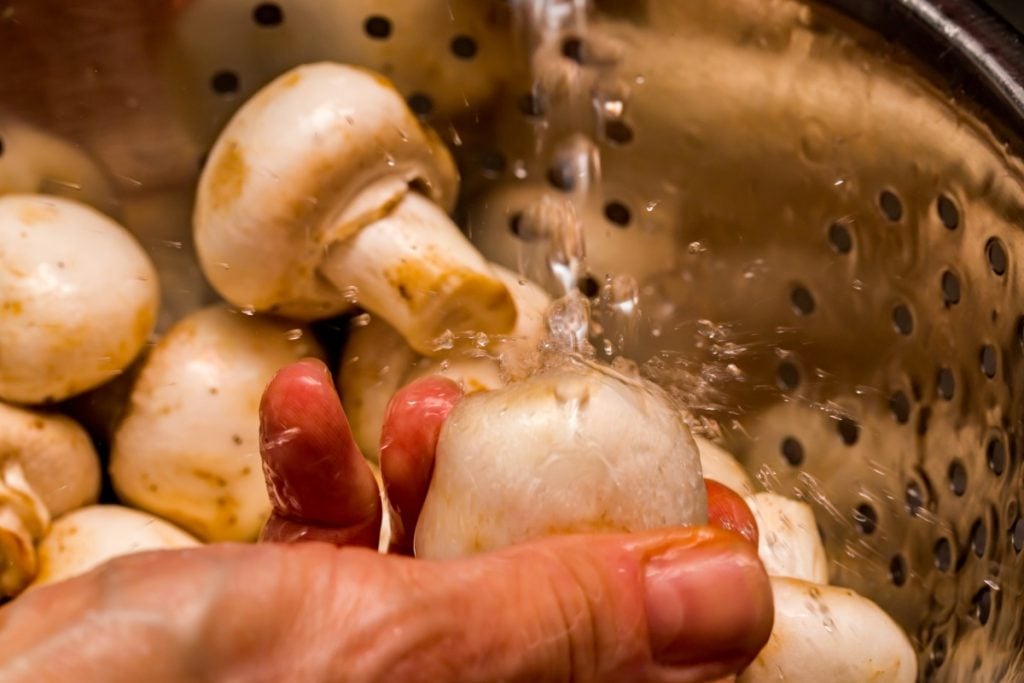
A quick rinse under cool running water is the most frequently used method, especially for mushrooms that aren’t particularly dirty.
There are several ways you can approach this.
- For mushrooms with smooth round caps like button, shiitake or portobello mushrooms, you can rinse them individually under running water while rubbing dirty spots with your fingers.
- A quicker way to rinse whole mushrooms is to place them all in a colander or strainer under cool running water. Shake the colander gently to move the mushrooms around and dislodge dirt.
- A salad spinner also works well. Place whole mushrooms in the basket of a salad spinner and rinse them with running water until you have removed all debris.
Bowl Method

This method works well for dirtier mushrooms with nooks and crannies that are hard to reach.
Place your mushrooms in a bowl of cool water and swish them around to dislodge dirt and debris. You should see the dirt coming off the mushrooms and settling on the bottom of the bowl.
Remove the mushrooms from the bowl as soon as they’re clean, usually less than a minute, to avoid getting them waterlogged.
Step 3: Drying
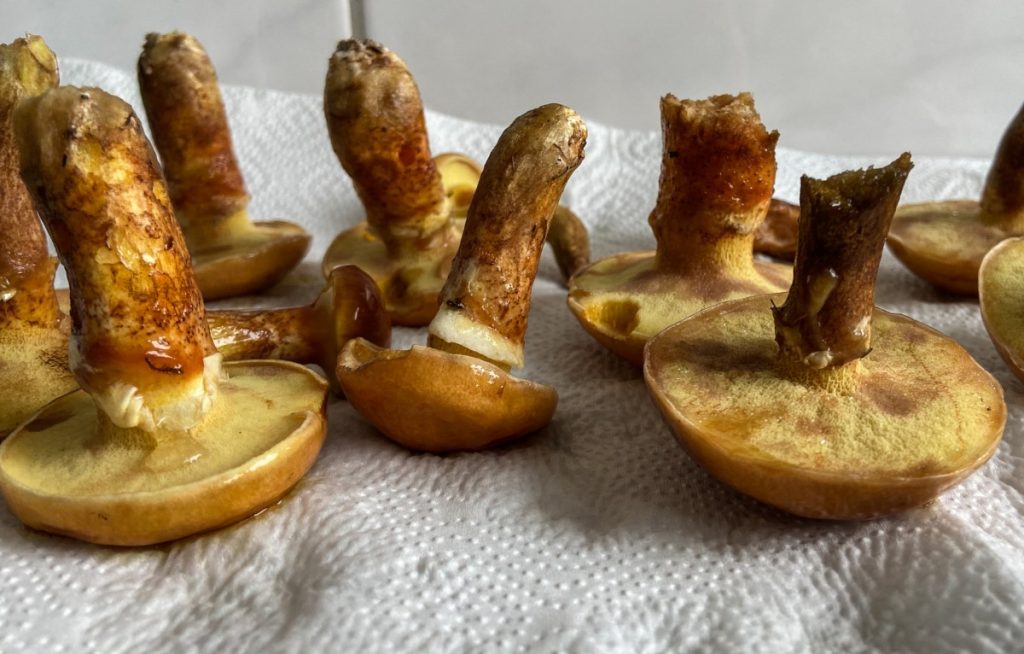
Before cooking your newly cleaned mushrooms, you need to make sure they’re dry.
Some types of firm mushrooms you can gently pat dry with a clean kitchen cloth or paper towel.
Lay other, more delicate mushrooms out to dry on kitchen towels or a paper-towel-lined baking sheet.
If you’re using a salad spinner to rinse your mushrooms, first spin the mushrooms dry and then use paper towels to remove any remaining water.
Step by Step Guide to Cleaning Morel Mushrooms
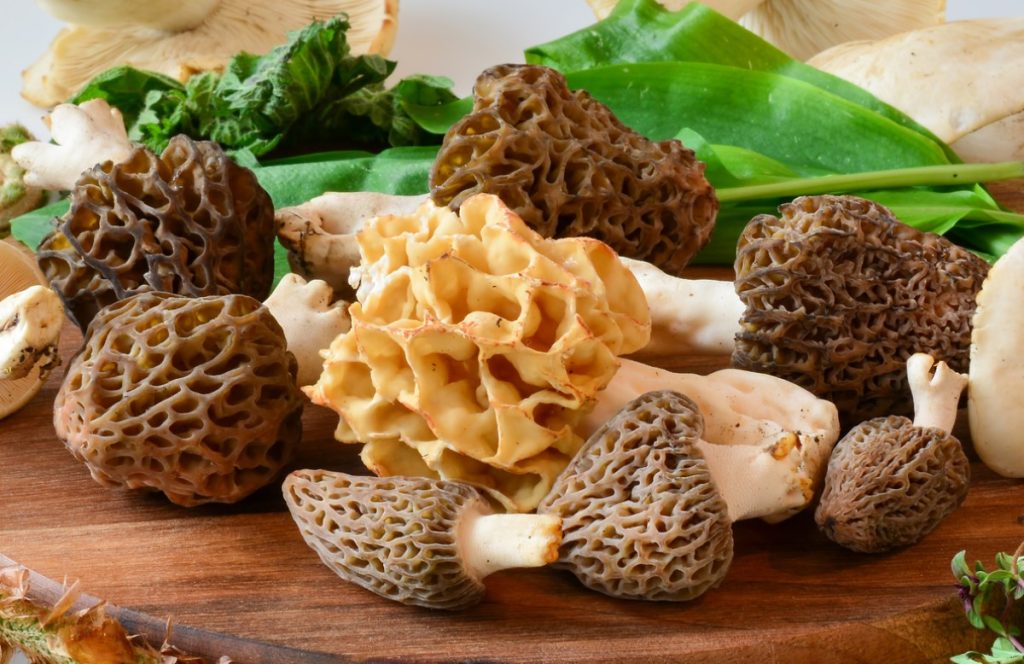
Morel mushrooms are some of the most sought-after wild mushrooms and some of the most expensive mushrooms in the world.
Their distinctive honeycomb appearance means they have lots of nooks and crannies for dirt and insects to hide in.
The bumpy texture makes them harder to clean, and you may be wondering how to clean morel mushrooms properly.
Like other mushrooms, you should only clean morels just before cooking them.
Here are four steps for cleaning morel mushrooms:
Step 1: Shaking
The first step when cleaning morel mushrooms is to shake off as much dirt as possible.
Put your morels in a paper bag, lidded bowl or colander and shake vigorously, but not too violently as you don’t want the mushrooms to break apart or bruise.
The goal is to loosen and remove as much dirt as possible before washing them.
When you’re done, carefully lift the morels out of the bag, bowl or colander, leaving the dirt and debris behind.
Step 2: Slicing
Using a small, sharp knife, slice the morels in half lengthways from tip to stem.
This step is optional, but we feel it’s a good idea as it makes it easier to clean inside the hollow stem, where you often find dirt and insects.
After halving the morels, trim off any sections that are especially dirty or damaged by bugs.
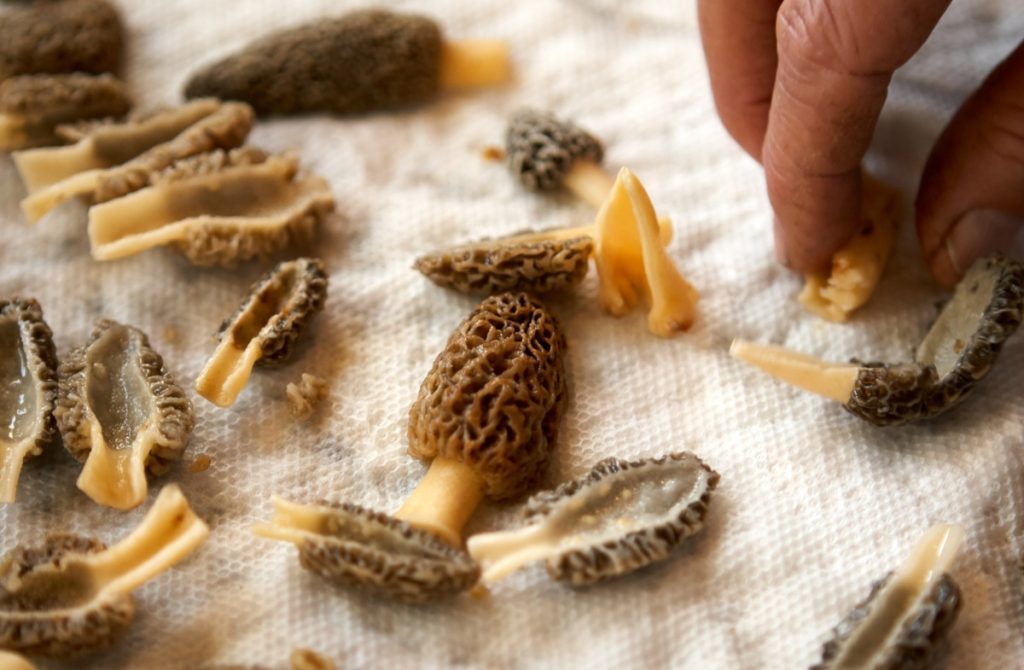
Step 3: Rinsing
Put the sliced and trimmed morels into a bowl of cold water and swish them around to loosen any remaining dirt.
Keep going until you stop seeing dirt coming off the morels. Then remove the morels from the water, leaving any grit, debris and insects at the bottom of the bowl.
If the mushrooms are relatively clean, this should be enough.
But, if the water is very dirty, you may want to repeat the process until there’s no more dirt coming off the morels.
After the first rinse, some people like to soak morels in lightly salted water to kill any insects.
Soaking isn’t always necessary, but it can be helpful if your morels are very dirty or bug-infested.
Step 4: Drying
When the morels are clean, pat them dry using a kitchen towel or paper towels.
Remember to jostle them gently as you dry them to get all the water out of the morels honeycomb cap.
How to Clean Sliced Mushrooms
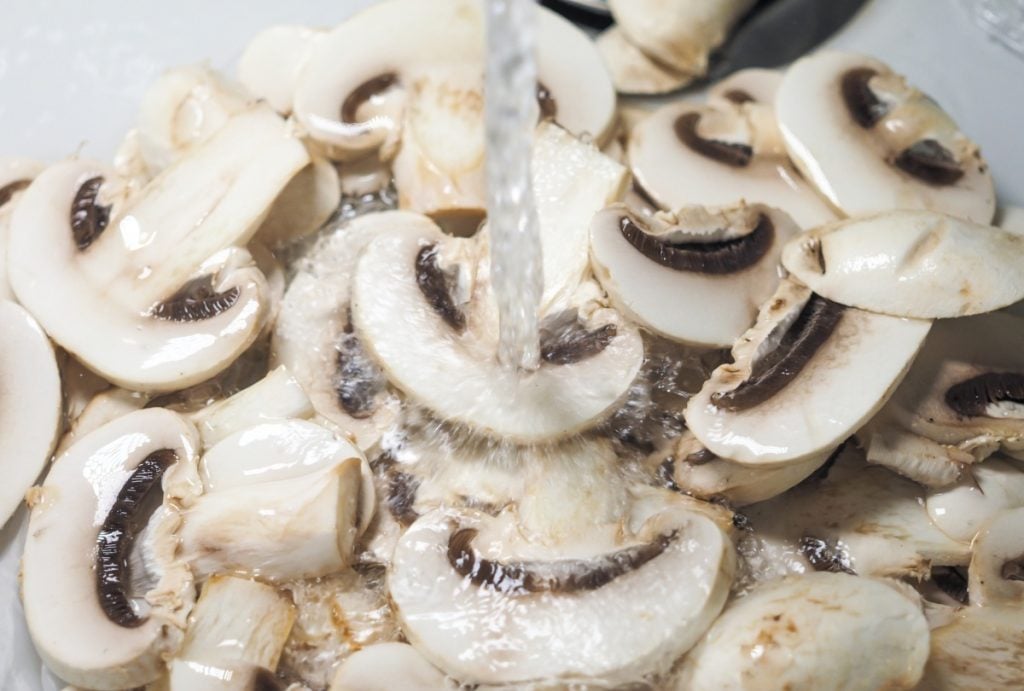
If you’ve purchased sliced mushrooms from the supermarket, cleaning them is not the same as cleaning whole mushrooms.
Often pre-sliced mushrooms will come already cleaned and won’t need much washing.
Sliced or chopped mushrooms are also more prone to absorbing water than whole mushrooms, so if they look clean, avoid washing them at all.
Steps to clean sliced mushrooms:
Step 1: Shaking
Place them in a colander and shake them lightly to loosen any dirt.
Step 2: Rinsing
Give them a quick rinse with running, cold water.
Step 4: Drying
Pat them dry with a clean kitchen cloth or paper towels and cook them immediately.
How to Clean Mushrooms For Stuffing
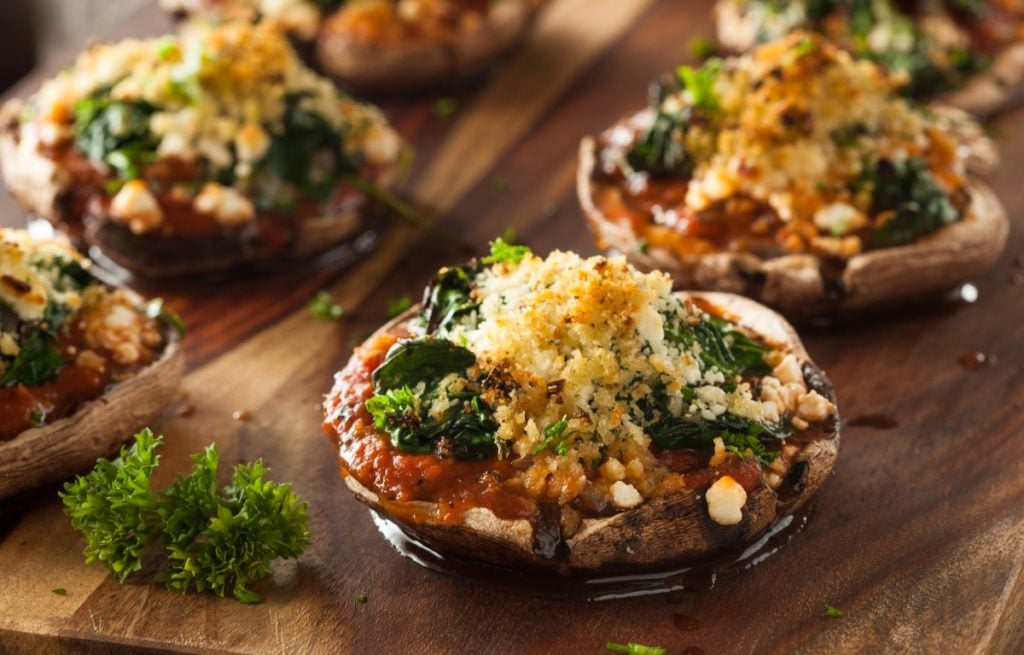
Portobello mushrooms have nice big caps and are one of the most commonly stuffed mushrooms. But, you can also stuff large white mushrooms and cremini mushrooms.
Here’s how to clean portobello mushrooms for stuffing.
Step 1: Trimming
First, remove the stem. Generally, portobello stems snap off easily but, if needed,
use a small sharp knife to remove the stem where it meets the cap.
Keep the stems. You can chop them up to use as part of the stuffing or freeze them for future use. Mushroom stems are full of flavor, and you can use them in several ways.
Trim off any other damaged or bruised sections of the mushroom cap.
Step 2: Removing gills
Next, you need to remove the gills. Hold the portobello in your hand with the gills facing up, and using a spoon, lightly scrape off the gills.
They will scrape off very easily, and if you miss any, you can go back around the mushroom again.
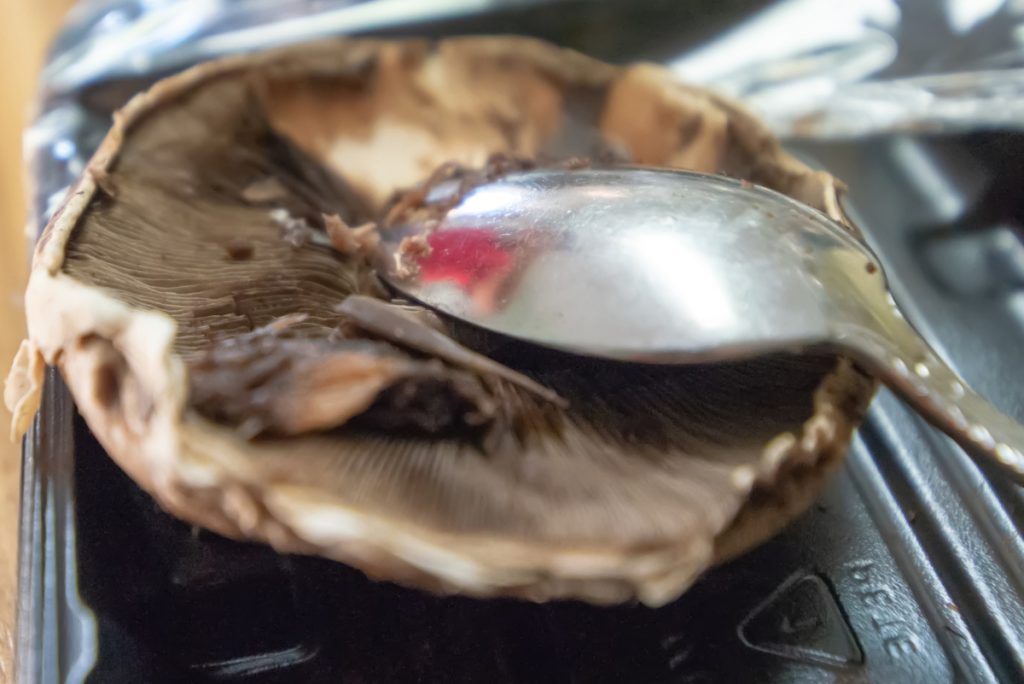
Step 3: Rinsing
When you have removed all the gills, rinse the portobello cap quickly under running water. It will remove any gill remnants as well as any dirt on the top.
Step 4: Drying
Pat the cap dry with a clean cloth or paper towels, and now you’re ready to stuff your portobello mushrooms.
How to Clean Oyster Mushrooms

Oyster mushrooms are one of our favorite mushrooms. They’re one of the easiest types of mushrooms to grow, and when growing them in bags or buckets, there’s very little mess.
Because oyster mushrooms grow on substrates like wood, cardboard or coffee grounds, they aren’t in contact with dirt. Which means they need little cleaning before cooking.
You can usually just wipe them gently with a paper towel. Or, if you want to wash your oysters, a quick rinse under running water will do the trick, and then leave them dry on a clean towel.
How to Store Mushrooms After Cleaning Them
It’s best to clean mushrooms shortly before you cook them. Because, regardless of the method you use, washing mushrooms increases the chance of them becoming slimy, moldy or rotten.
But, you can keep your clean, dry mushrooms in the refrigerator for up to a day if necessary.
Store washed mushrooms in the refrigerator in a vegetable-type plastic bag with holes, a slightly open zipper bag or a container covered in plastic wrap with small holes.

How Long Do Mushrooms Last?
When you store fresh mushrooms correctly, they can last for up to a week in the refrigerator. But, once washed, you should use them as soon as possible as they’ll usually only last a day.
Here are some tips to help you keep unwashed mushrooms fresh for longer.
If you’re buying mushrooms that come wrapped in a plastic tray, it’s best to store them in your refrigerator in their original packaging.
If you leave mushrooms shrink-wrapped as they come from the store, they can keep at least a week in the refrigerator with little to no browning.
If you buy loose mushrooms from a farmer’s market, store them in a container that’s just big enough to hold them. Cover the top with plastic wrap with a few small holes poked in it, making it breathable.
Alternatively, you can store loose mushrooms in a partially open bag.
Storing mushrooms like this keeps them fresher as it allows the ethylene gas they produce to escape. It also provides air circulation but not enough to dry them out.
Always store your mushrooms in the main compartment of your refrigerator. The crisper drawer is too moist and doesn’t allow enough airflow.
Avoid stacking other items on top of your mushrooms as they bruise easily and won’t last long.
For more information on storing mushrooms read our article, “How Long Do Mushrooms Last? Everything You Need To Know.”
Final Thoughts
Always clean mushrooms properly, especially if you are feeding them to your baby, so that you can enjoy their flavor and texture safely without grit or insects.
A quick rinse in cold water is the best way to clean most mushrooms and does not cause them to become waterlogged.
Always make sure your mushrooms are dry before cooking them so that you keep their unique flavor and texture.
Visit our Mushroom Education Hub to learn how to cook with mushrooms and discover 30 of the best mushroom recipe ideas.
